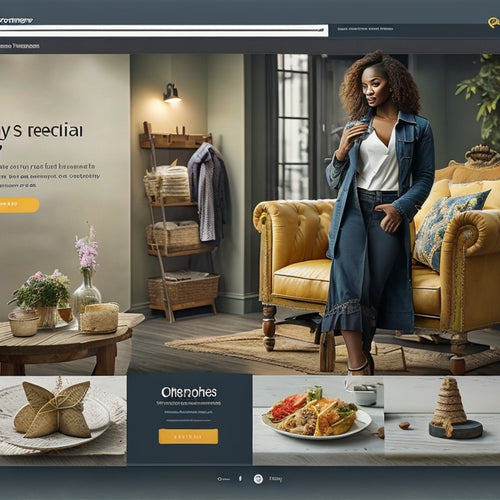
Grow Sales With Online Courses and Digital Downloads
Share
You're sitting on a goldmine of expertise, and turning it into online courses and digital downloads can open a profitable revenue stream that grows your sales exponentially. By monetizing your knowledge and skills, you can create a revenue stream for an existing business or standalone venture. Focus on developing engaging, informative course content that solves specific problems for your target audience. As you continue to refine your products and customer engagement strategies, you'll be well on your way to driving repeat business, generating referrals, and fostering customer loyalty. Now, discover the secrets to turning your expertise into a thriving online business.
Key Takeaways
• Monetize expertise by creating online courses that solve specific problems for a targeted audience, generating a new revenue stream.
• Develop engaging, informative course content that addresses customer pain points, increasing customer loyalty and advocacy.
• Leverage email marketing automation and irresistible course descriptions to drive sales and maximize profit.
• Partner with affiliates to increase exposure and scale sales with minimal upfront costs and measurable results.
• Offer digital downloads as a flexible and interactive learning experience, enhancing customer engagement and driving repeat business.
Selling Expertise Through Online Courses
By packaging your expertise into online courses, you can monetize your knowledge and skills, creating a lucrative revenue stream that can supplement your existing business or even become a standalone venture. This is an excellent way to capitalize on your unique strengths and share your expertise with others.
But before you start creating your course, defining your target audience becomes crucial. Who are they, and what problems do they need solving? What're their pain points, and how can your expertise help them overcome these challenges?
Once you have a clear understanding of your target audience, you can start developing course content that resonates with them. This content should be engaging, informative, and structured in a way that's easy to follow. You'll want to break down complex topics into bite-sized modules, using a mix of text, images, and multimedia to keep students engaged.
Creating Digital Products That Sell
You've successfully packaged your expertise into online courses, now it's time to explore another lucrative revenue stream: creating digital products that solve specific problems or cater to specific needs, allowing you to tap into a wider market and increase your online earnings.
To create digital products that sell, you need to focus on product development and customer engagement. This involves understanding your target audience's pain points and creating products that address those needs. Conduct market research to identify gaps in the market and validate your product ideas. Then, create high-quality content that resonates with your audience.
Here are some key considerations for creating digital products that sell:
| Product Development | Customer Engagement |
| Identify target audience needs | Conduct market research to validate product ideas |
| Create high-quality content | Develop products that solve specific problems |
| Develop products that cater to specific needs | Foster customer engagement through feedback and support |
| Continuously iterate and improve products | Encourage customer loyalty through exceptional customer service |
Building Loyal Customer Communities
Developing a loyal customer community requires intentional effort, as it's the key to driving repeat business, encouraging positive word-of-mouth, and generating a steady stream of referrals. You can achieve this by fostering customer engagement through exclusive content, such as behind-the-scenes insights, early access to new products, or expert Q&A sessions. This makes customers feel valued, appreciated, and part of an elite group.
To build a loyal community, you need to focus on community building. This involves creating a dedicated space, such as a private Facebook group or online forum, where customers can connect, share ideas, and get support. By doing so, you'll encourage customer loyalty, as customers will feel invested in your brand and more likely to advocate for it.
Crafting Irresistible Course Descriptions
What makes your online course stand out in a crowded market, and how can you convey its unique value to potential customers? Your course description is often the first impression people have of your product, so it's essential to get it right.
You want to entice them to sign up, not scroll past. To craft an irresistible course description, you need to speak directly to your target audience's pain points and desires. Use power words like 'transform,' 'unleash,' and 'revolutionize' to evoke emotions and create a sense of urgency.
Employ storytelling techniques to make your course relatable and memorable.
Here are three key elements to include in your course description:
- Specific benefits: What'll students gain from taking your course?
- Unique selling points: What sets your course apart from others in the market?
- Social proof: What do past students or experts say about your course?
Pricing Strategies for Maximum Profit
Now that you've crafted an irresistible course description, it's time to focus on pricing your online course to maximize profit, a decision that can make or break your sales strategy.
You want to set a price that reflects the value your course provides, while also being attractive to potential customers. To achieve this, consider implementing discount strategies, such as limited-time offers or bundle deals, to incentivize sales. However, be careful not to devalue your course by discounting it too heavily.
On the other hand, you can create upsell opportunities by offering premium content or exclusive access to additional resources. This not only increases the average order value but also enhances the customer experience.
Another approach is to offer tiered pricing, where customers can choose from different levels of access or support. By testing different pricing strategies, you'll be able to find the sweet spot that maximizes your profit while still appealing to your target audience.
Leveraging Email Marketing Automation
By automating your email marketing, you can precision-target potential customers with personalized content, nurturing them through the sales funnel and priming them to buy your online course or digital download.
With automation, you can set up drip campaigns that send targeted emails to specific segments of your audience. This allows you to tailor your messaging to their specific needs and interests, increasing the likelihood of conversion.
For example:
- You can create a welcome series that introduces new subscribers to your brand and content
- You can set up abandoned cart reminders to re-engage potential customers who left items in their cart
- You can create targeted promotional emails based on user behavior, such as completing a course or achieving a specific milestone
In addition to segmentation, automation also enables personalization and A/B testing. You can use customer data to personalize email content, subject lines, and even send times to maximize engagement. A/B testing allows you to experiment with different approaches and refine your strategy based on data-driven insights.
Optimizing Course Landing Pages
When you create a course landing page, you're creating a sales pitch that convinces visitors to buy your online course.
To make that pitch effective, you need to craft a headline that grabs attention and highlights the benefits that distinguish your course from the rest.
Craft Compelling Headlines
Crafting a compelling headline is essential to grabbing the attention of potential customers and enticing them to explore your course landing page further. You want to stop them in their tracks and make them curious about what you have to offer.
To do this, you need to use power words that evoke emotions and create a sense of urgency. Here are some tips to get you started:
- Use action-oriented language like 'Get Instant Access' or 'Transform Your Skills'
- Create a sense of scarcity with words like 'Limited Time Offer' or 'Exclusive Opportunity'
- Use questions that resonate with your target audience, such as 'Want to Boost Your Productivity?' or 'Ready to Take Your Career to the Next Level?'
Highlight Key Benefits
You'll enhance the chances of selling your online course by highlighting the key benefits that set it apart from others and resonate with your target audience's needs and desires. By doing so, you'll create a compelling narrative that speaks directly to their pain points and aspirations.
For instance, if your course teaches entrepreneurial skills, emphasize how it can help learners generate passive income streams or expand their business's global reach. This will help potential customers visualize the tangible results they can achieve by taking your course.
When highlighting key benefits, be specific and use concrete language. Instead of saying 'improve your marketing skills,' say 'learn how to create a social media strategy that drives 50% more leads.' Use bullet points or short paragraphs to make the benefits easy to scan and digest.
Remember, the goal is to create a sense of urgency and excitement around your course. By showcasing the unique value it offers, you'll increase the chances of converting visitors into customers.
Scaling Sales With Affiliate Partners
By tapping into the collective reach of affiliate partners, you can exponentially expand your customer base and put your online courses and digital downloads on the fast track to success. This is because affiliate partnerships allow you to leverage the promotional strategies of others to reach new audiences. When done correctly, affiliate partnerships can be a highly effective way to scale your sales and increase revenue.
Here are some key benefits to ponder:
-
Increased exposure: Affiliate partners can promote your products to their own audiences, generating buzz and driving traffic to your site.
-
Minimal upfront costs: You only pay commissions on sales generated through affiliate referrals, making it a low-risk investment.
-
Scalable results: With multiple affiliates promoting your products, you can see a significant increase in sales and revenue.
Frequently Asked Questions
Can I Sell Online Courses if I'm Not an Expert in My Field?
"Fake it till you make it" doesn't apply here. You can still sell online courses even if you're not an expert, as long as you create high-quality content and develop effective marketing strategies that showcase your unique perspective and skills.
How Do I Handle Customer Refunds and Complaints Politely?
When handling refunds, you'll want to respond promptly, apologize sincerely, and offer a hassle-free process. When managing complaints, you'll need to listen actively, empathize genuinely, and provide a constructive solution to turn critics into loyal fans.
What's the Ideal Length for an Online Course or Digital Download?
Imagine a perfectly crafted hourglass, where every grain of sand represents a learner's attention. You're aiming for an ideal duration that balances engagement and completion rates, where users stay hooked till the very end, retaining every valuable lesson.
Do I Need to Invest in Expensive Software for Course Creation?
You don't need to break the bank on fancy software for course creation. You can find free alternatives and simplified tools that'll get the job done, saving you time and money.
Can I Use Online Courses to Sell Physical Products or Services Too?
Imagine holding the keys to a treasure chest, overflowing with opportunities. Yes, you can use online courses to sell physical products or services too, by integrating products and service offerings, seamlessly bridging the digital-physical gap, and accessing new revenue streams.
Related Posts
-
The Power Of Shoppable Videos: Revolutionizing Ecommerce
Shoppable videos have emerged as a game-changer in the ecommerce industry, reshaping the way customers interact with ...
-

Streamlining Your Shopify Store for Long-Term Reliability With Automation
The implementation of automation in Shopify stores has emerged as a significant strategy for businesses seeking to o...
-

Should I Add Reviews to My Shopify Store
The inclusion of customer reviews in e-commerce platforms has become a topic of interest and debate among Shopify st...

